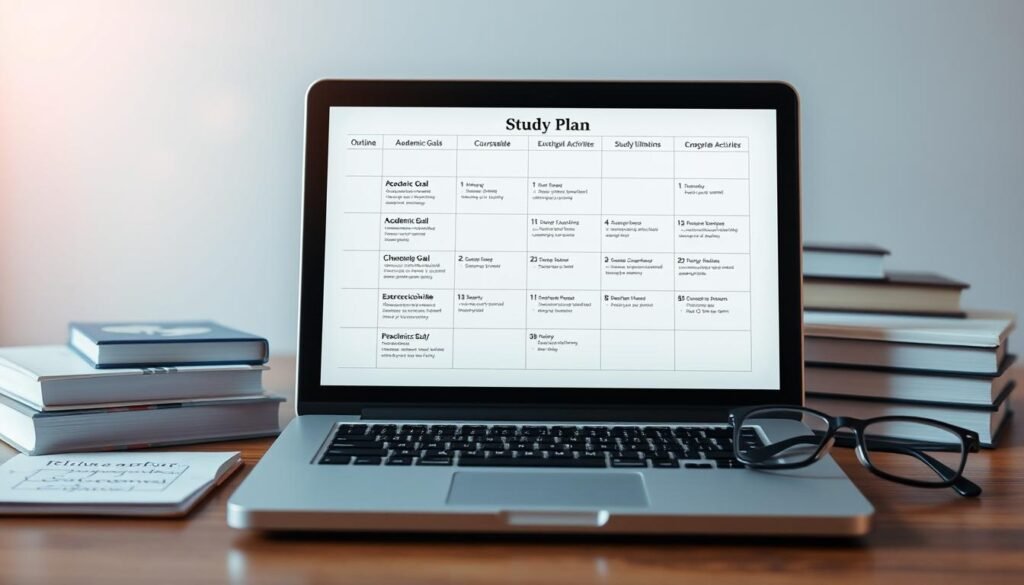Have you ever wondered what sets successful scholarship applicants apart? The secret often lies in their ability to present a clear and structured approach to their academic and personal goals. Crafting a well-thought-out strategy can make all the difference when competing for limited opportunities.
Universities like the University of Washington and Stetson provide downloadable examples that highlight the importance of organization. These templates include essential components such as health management and progress tracking, ensuring applicants stay on top of their commitments.
With scholarship competition rates soaring, demonstrating your dedication through a structured approach is more critical than ever. A well-prepared strategy not only showcases your commitment but also helps you stand out in a crowded field.
Key Takeaways
- Define the purpose of a structured approach for applicants.
- Access downloadable examples from top universities.
- Include health management and progress tracking in your strategy.
- Showcase commitment to scholarship committees effectively.
- Understand the urgency of high competition rates.
Introduction to Study Plan for Scholarship
A well-structured roadmap can be the key to unlocking scholarship opportunities. It serves as a strategic tool that outlines your academic career goals and demonstrates your commitment to achieving them. This approach not only helps you stay organized but also impresses scholarship committees with your dedication.
What is a Study Plan?
A study plan is a detailed strategy that acts as a roadmap for your educational journey. It includes four key functions: planning, demonstrating commitment, managing resources, and balancing well-being. For example, John Deo’s professional formatting standards show how a well-crafted plan can stand out.
Unlike visual schedules or timetables, study plans are often presented in essay format. This allows applicants to explain their goals and strategies in a narrative style, making it easier for committees to understand their vision.
Why is a Study Plan Important for Scholarship Applications?
With competition rates soaring, such as the Chinese Government Scholarship’s high applicant numbers, a study plan is more critical than ever. It addresses committee priorities by showcasing your ability to manage time, resources, and personal well-being.
Case studies reveal that applicants with clear plans are more likely to succeed. For instance, one candidate’s detailed approach to balancing academics and extracurriculars impressed the committee, leading to their selection. A well-prepared plan not only highlights your strengths but also sets you apart in a crowded field.
Understanding the Scholarship Requirements
Navigating scholarship requirements is a critical step in crafting a standout application. Each program has unique criteria, and understanding these can make or break your chances. Start by thoroughly reviewing the guidelines provided by the scholarship committee.
How to Review Scholarship Guidelines
Scholarship guidelines often include specific expectations, such as academic achievements, extracurricular involvement, and personal essays. For example, the NTDC internship program emphasizes practical experience, so tailoring your application to highlight relevant skills is key.
Use this 5-point checklist to decode the rubrics:
– Identify the program’s core objectives.
– Highlight your strengths that align with these goals.
– Address any specific questions or prompts.
– Avoid generic responses; customize your application.
– Double-check for red flags like vague language or incomplete sections.
Aligning Your Strategy with Scholarship Objectives
Aligning your goals with the program’s objectives is essential. Take the Dawlance Group project, which matched STEM scholarship criteria by showcasing innovation and technical expertise. This approach impressed the scholarship committee and secured the award.
Here’s a comparison of generic vs. customized elements:
– Generic: Broad academic goals.
– Customized: Specific research projects aligned with the program’s focus.
– Generic: General interest in the field.
– Customized: Detailed career plans and contributions to the industry.
Avoid phrases like “I hope to learn” or “I might pursue.” Instead, use confident language such as “I will achieve” or “I am committed to.” This demonstrates clarity and determination to the scholarship committee.
Setting Academic Goals
Academic goals act as a compass for your educational journey. They help you stay focused and motivated, whether you’re aiming for a high GPA or preparing for a research publication. By defining what you want to achieve, you create a roadmap that guides your efforts and keeps you on track.
Short-Term vs. Long-Term Academic Goals
Short-term goals are immediate targets, like maintaining a 3.8 GPA or completing a project. Long-term goals, such as publishing research or earning a degree, require sustained effort over time. Both types are essential for success, as they complement each other and provide a balanced approach to achievement.
How to Set Realistic Academic Goals
Using the SMART framework can help you set achievable goals. For example, the University of Wyoming’s energy-saving project demonstrates how specific, measurable, and time-bound objectives lead to success. Avoid overambitious goals by breaking them into smaller, manageable steps. This approach ensures steady progress and reduces the risk of burnout.
Common mistakes include setting vague goals or neglecting to track progress. Instead, use tools like the 9-8-7 study method to adapt your timeline and stay organized. By aligning your goals with your capabilities, you’ll set yourself up for long-term success.
Creating a Time Management Plan
Effective time management is the cornerstone of achieving both academic and personal success. A well-structured approach ensures you can juggle multiple responsibilities without feeling overwhelmed. By prioritizing tasks and allocating time wisely, you can maximize productivity and reduce stress.
Balancing Academic, Extracurricular, and Personal Activities
Balancing academics, extracurriculars, and personal life requires careful planning. Start by identifying your priorities and allocating specific blocks of time for each. For example, John Deo’s 20-hour weekly structure divides focus between coursework, projects, and leisure, ensuring a balanced approach.
Tools like color-coded schedules, as seen in TrentU’s example, can help visualize your commitments. This method allows you to spot overlaps and adjust your routine accordingly. Remember, flexibility is key to maintaining balance without burnout.
Weekly and Daily Study Schedules
Creating a weekly and daily schedule helps you stay organized and focused. Break down tasks into smaller, manageable chunks to avoid feeling overwhelmed. The Pomodoro technique, for instance, involves 25-minute focused sessions followed by short breaks, which can boost productivity.
Optimizing your activities can lead to significant improvements. The Dawlance Group saved 1.2M PKR by streamlining their scheduling process. Similarly, aligning your study sessions with your peak energy levels can enhance efficiency.
Comparing traditional and flipped classroom time allocations can also provide insights. While traditional methods focus on in-class learning, flipped classrooms emphasize self-study, allowing for more personalized schedules.
Developing a Daily Study Routine
Building a daily routine can transform your academic performance and productivity. A consistent schedule helps students stay focused, manage their coursework, and achieve their goals. By incorporating proven techniques, you can maximize your learning potential and retain information more effectively.
Effective Study Techniques
Active recall, as implemented by Stetson University, is a powerful method for enhancing memory. This technique involves actively retrieving information rather than passively reviewing it. Another approach is the Feynman technique, which simplifies complex concepts by teaching them to others.
Learning styles also play a role. For example, auditory learners benefit from listening to lectures, while kinesthetic learners thrive with hands-on activities. RIOHondo samples show how tailoring your routine to your learning style can improve outcomes.
Maximizing Retention and Learning
Spaced repetition is one of the most evidence-based retention boosters. This method involves reviewing material at increasing intervals to reinforce memory. The SCADA system learning approach from the NTDC internship demonstrates how structured, repetitive practice can lead to mastery.
To troubleshoot common routine breakdowns, identify distractions and adjust your schedule accordingly. For instance, if you’re struggling to focus, try the Pomodoro technique—25 minutes of work followed by a 5-minute break.
By combining these strategies, students can create a daily routine that enhances their coursework and sets them up for long-term success.
Utilizing Academic Resources
Leveraging academic resources can significantly enhance your educational journey. Start by exploring the university libraries, like those at UWash, which offer access to journals, databases, and study spaces. These resources are invaluable for research and coursework.
Engaging with professors is another key strategy. Success stories from Chinese scholarship applicants highlight the importance of building strong mentor relationships. Regular communication and seeking feedback can open doors to new opportunities.
Collaboration with industry, as seen in the NTDC model, bridges the gap between academia and real-world applications. This approach not only enhances learning but also prepares you for your future field.
Digital tools like Mendeley and Zotero streamline research management, making it easier to organize references and citations. Finally, crafting professional emails to request recommendation letters ensures you leave a lasting impression.
FAQ
What is a study plan?
A study plan is a detailed schedule that outlines your academic activities, goals, and timelines. It helps you stay organized and focused on achieving your educational objectives, especially when applying for scholarships.
Why is a study plan important for scholarship applications?
A study plan demonstrates your commitment to academic success and your ability to manage time effectively. Scholarship committees often look for candidates who have clear goals and a structured approach to their education.
How do I review scholarship guidelines?
Carefully read the scholarship requirements provided by the organization. Pay attention to deadlines, eligibility criteria, and specific instructions for submitting your application. This ensures your study plan aligns with their expectations.
How can I align my study plan with scholarship objectives?
Tailor your study plan to reflect the scholarship’s mission and goals. Highlight how your academic and career aspirations align with their values, and emphasize how the scholarship will help you achieve your objectives.
What is the difference between short-term and long-term academic goals?
Short-term goals focus on immediate achievements, such as completing a course or improving grades. Long-term goals involve broader aspirations, like earning a degree or pursuing a specific career path.
How do I set realistic academic goals?
Break down your goals into manageable steps, considering your current abilities and resources. Ensure they are specific, measurable, and achievable within the given timeframe.
How can I balance academic, extracurricular, and personal activities?
Prioritize tasks based on importance and deadlines. Allocate specific time slots for studying, extracurriculars, and personal activities to maintain a healthy balance.
What should a weekly or daily study schedule include?
Include dedicated time for each subject, review sessions, and breaks. A well-structured schedule helps you stay on track and reduces stress.
What are some effective study techniques?
Techniques like active recall, spaced repetition, and summarizing key points can enhance learning. Experiment with different methods to find what works best for you.
How can I maximize retention and learning?
Focus on understanding concepts rather than memorizing. Use tools like flashcards, mind maps, and practice tests to reinforce your knowledge.
How can I utilize academic resources effectively?
Take advantage of libraries, online databases, and study groups. Seek guidance from professors or academic advisors to enhance your learning experience.









